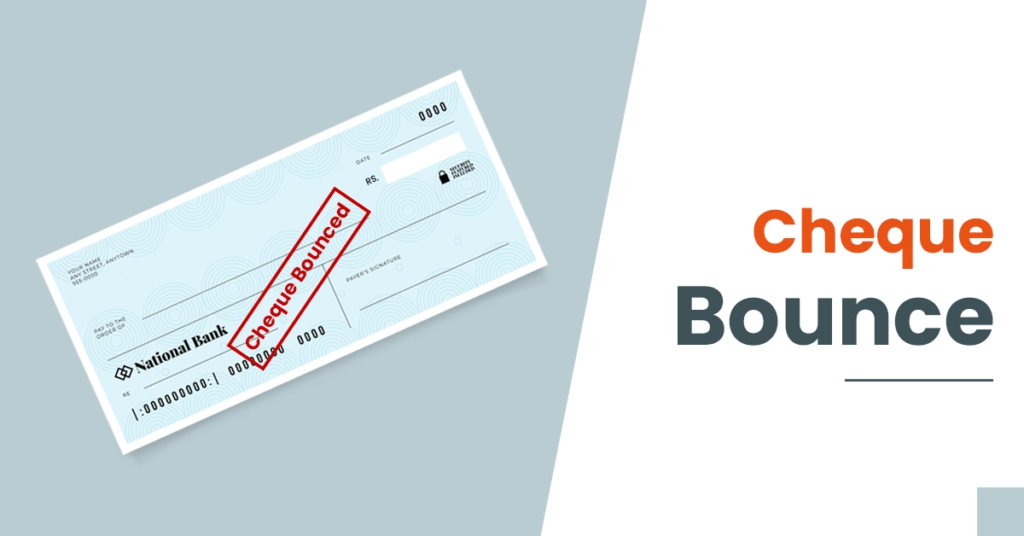Cheque Bounce Case and Steps to Avoid it: When an issued check is submitted for payment and the issuing bank declines to honor it owing to inadequate funds or other factors, the transaction is known as a "cheque bounce." The Negotiable Instruments Act makes this a crime. The issuer may be subject to sanctions including fines or jail time. When a check bounces, banks may levy penalties and extra fees, including a penalty fee.
These fees differ between banks and are based on the kind of account the customer has and variables such as the size of the check. The payee may also demand payment from the issuer for the difficulty they caused. Legal recourse is possible in the event of a dispute, but legal complications and costly consequences related with cheque bounces and charges in India are best avoided through prevention.

In India, the term “cheque bounce charges” refers to the fees that banks incur when a check presented for payment is returned for insufficient money or for another reason. These fees are also sometimes referred to as “NSF charges” or “bounce charges.”
The person who issued the cheque (the drawer) is normally responsible for covering these fees for the bank or the recipient when a check fails. Section 138 of the Negotiable Instruments Act of 1881 governs instances involving returned checks.
A Cheque Bounce Case’s Procedure (Cheque Bounce Case and Steps to Avoid it)
Step 1: Sending a Demand Notice to the individual who gave you a bounced cheque
Step 2: Information about the returned check should be included in the message. Information like the date the check was issued and a copy of the memo that was rejected should be included in the notification.
Step 3: After receiving the notification, the individual has 15 days to reimburse you.
Step 4: If they don’t, you can submit a complaint to the court using the forms specified.
Step 5: In addition to the complaint form, you must also provide an oath letter, a copy of the notification given with the acknowledgement receipt, a photocopy of the memo, and the cheque that bounced.
Step 6: After the court is satisfied with your cheque return case, the complainant or their attorneys must complete the bhatta or cheque bounce case process form, after which the accused is required to appear in court. Step 6: When the judicial court receives your complaint, it will review and verify the documents you sent.
Step 7: The judge has the power to issue a bailable warrant against the accused if they fail to show up for court.

India’s legal repercussions for a bounced check
A bounced check is a criminal violation in India according to the Negotiable Instruments Act of 1881. Legal repercussions for a bounced check include:
- Legal Notice: If a check bounces, the payee (the person to whom the check was issued) may, within 30 days of receiving the bank’s bounce notification, submit a legal notice to the issuer (the person who wrote the check), requesting payment of the amount of the cheque.
- Demand for Repayment: The issuer must pay the payee within 15 days of receiving the legal notification. The payee may pursue legal action if the payment is not made within this time frame.
- Criminal Complaint: The payee may file a criminal complaint against the issuance if the issuer does not pay the check amount within 15 days of receiving the legal notification. An appropriate court having authority over the case may receive the complaint.
- Court procedures: The issuer will be the subject of court proceedings, and if proven guilty, the issuer might be sentenced to up to two years in jail, a fine, or both. The issuer may be compelled by the court to compensate the payee.
- Civil Action: In addition to filing a criminal complaint, the payee may also bring a civil action to collect the amount of the bounced check as well as any extra damages, interest, and legal costs.
How to avoid Cheque Bounce Situations
Maintain Sufficient Balance: Before writing a check, make sure you have enough money in your account to cover the whole amount. Keep a close eye on your spending and account balance to avoid being overdrawn.
- Plan ahead: Before writing a check, estimate your future costs and obligations to make sure you have enough money on hand to cover them until the check is presented for payment.
- Communicate with the payee and provide alternate payment choices or a postponed payment date if there is a chance that there won’t be enough money to cover the bill.
- Post-Dated Cheques: To prevent misunderstandings, be careful to let the payee know if you are issuing post-dated checks.
- Verification: To reduce mistakes, double-check the cheque’s amount in words and numbers, the date, and other information.
- Halt Payments: Contact your bank right away if you need to halt a check for any reason, and then follow their instructions for requesting a stop payment order.
- Update bank information: To ensure that you get notices quickly, keep your bank informed of any changes to your contact information or account information
- Electronic Transactions: Because they offer real-time information on your account balance and transactions, you might choose to use electronic cash transfers, internet banking, or digital payment options.
- Maintain Records: To prevent overcommitting money, keep track of all your transactions, including check issuances.
- Maintain an emergency reserve in your account to cover unforeseen costs or delays.
- Regular Account Review: Examine your bank statements on a regular basis to look for any inconsistencies or problems with your account.
- Contact your bank to explore overdraft alternatives or other measures that might assist you prevent check bouncing if you anticipate any brief liquidity problems.
- Explicit directions: To avoid problems, ensure sure your directions for issuing checks are both explicit and unambiguous.
- Recipient Education: If you are a recipient of checks, inform your customers or clients of the value of keeping enough money on hand and communicating openly.

Conclusion
To preserve financial integrity and legal status in India, preventing check bounce situations is essential. People may reduce the risk of bounced checks by maintaining account balances responsibly, communicating clearly with payees, and using digital payment options.
The need of following excellent financial habits is further highlighted by understanding the legal ramifications and penalties of cheque bounce.
Cheque bounce problems may be avoided, confidence between parties to a transaction is fostered, and financial stability is preserved with the help of prompt communication, cautious preparation, and keeping precise records.
References
- Cheque Bounce Cases | Penalties & Notice Format – VakilSearch
- Consequences of Cheque Bounce Notice (cleartax.in)
- Dos & Don’ts of a Cheque Bounce Case in India | Cheque Bounce Law Guide (lawrato.com)